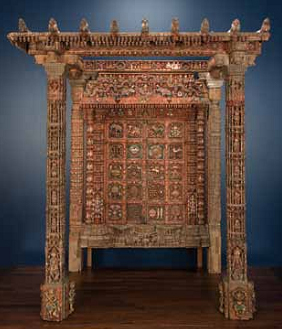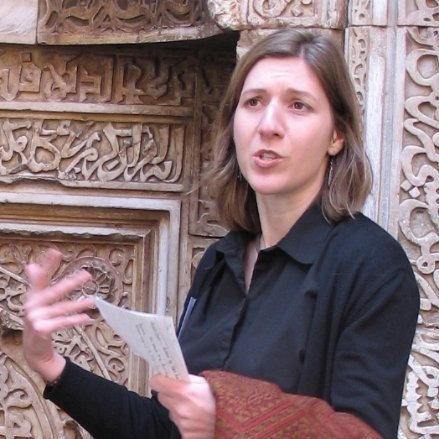
Centre of Jaina Studies Newsletter: SOAS - University of London
One of the great vernacular artistic traditions that flourished in medieval India is the wooden architecture found in Gujarat, in Western India. Many structures were created in this tradition, including largescale temples, urban homes and elaborately carved shrines. The ghar derasars, literally "house temples" of Gujarat were a unique development within this tradition. These shrines were created in Gujarat, for Jain patrons to use in private homes.
The ghar derasar appear to have taken two forms, free-standing shrines and architectural shrines that were integrated into the wall of a domestic space. The architectural shrines were large and elaborate structures, consisting of decorative shrine doors with multiple lintels and framing, frequently enclosed by a portico. Both forms of domestic shrines were created from wood and contained elaborate decoration, in the form of carvings, polychromy and metal overlay.
While other forms of Gujarati architecture and carving have been well-studied, the tradition of Jain domestic shrines has received little scholarly attention. With this in mind, I and my colleagues at The Nelson-Atkins Museum of Art, Kate Garland, Senior Objects Conservator and John Twilley, Mellon Conservation Scientist, began the treatment and study of a Jain ghar derasar from Gujarat in our museum's permanent collection. The discoveries made on this shrine during its treatment have inspired further study into the historical and artistic contexts of domestic shrine production in Gujarat, including collaboration with John Cort of Denison University. We also were assisted in our research by Rabindra Vasavada and Conservation Architect, Khushi Shah, both at the Centre for Environmental Planning and Technology (CEPT) University, Ahmedabad.
Background on the Nelson-Atkins Jain Shrine
The Jain shrine was acquired by the William Rockhill Nelson Trust in 1932, a year before the Nelson Art Gallery (now the Nelson-Atkins Museum of Art) opened to the public. Since the shrine's arrival at the museum, it has remained in storage awaiting extensive cleaning and restoration.
The shrine is an elaborately carved and painted wooden architectural structure comprised of the doors, lintel, jambs, portico, and supporting columns that formed the façade and entrance to a domestic Indian shrine (Figure 1). The shrine is filled with familiar Jain iconography, including a depiction of the goddess of fortune illustrated by elephants (gaja lakshmi) centered on the lintel, and depictions of the fourteen dreams of Queen Trishala (the mother of Mahavira, the last Tīrthaṅkara) and the eight auspicious Jain symbols (ashtamangala), in the square panels of the doors. A scene containing whiterobed monks reinforces the shrine's affiliation with the Svetambara sect of Jainism.
Cleaning and Analysis
In 2012 museum conservators began the long-anticipated treatment of the shrine. It was clear that the shrine was painted, but the decoration was completely obscured by dirt and grime. The first step was to consolidate the flaking paint with natural glues. Then, conservators tested various cleaning solutions on the stubborn grime layer. Solvent gels proved remarkably successful, revealing bright colors and gilding.
Scientific analysis undertaken during the treatment, supported by the Andrew W. Mellon Foundation, determined the date and type of wood used in the shrine and that the shrine had been refurbished. The wood was identified as teak, and radiocarbon dating of a sample from the timbers suggests that the wood was cut sometime between 1455 and 1635, pointing to a production period in the mid-16th century. Pigment samples indicate that two layers of paint exist on the surface of the wood. The uppermost layer of paint, now revealed by the cleaning, conceals an original layer comprised of colors such as natural ultramarine made with lapis lazuli, a very expensive pigment, indicating that the shrine was an important commission. The uppermost layer of polychromy contains an arsenic green paint, dating the more recent layer to the 19th century, as this synthetic pigment was commercially available only after 1811. However the color choices of the earlier and later layers appear to be the same, even if different pigments were used.

Figure 1. Jain Shrine Gujarat, India, 16th century. Wood, polychrome paint, gold leaf and glass inserts 70 x 57 5/8 x 7 in. (177.8 x 146.4 x 17.8 cm). The Nelson-Atkins Museum of Art, Kansas City, Missouri. Purchase: William Rockhill Nelson Trust, 32-136. Photo: John Lamberton © The Nelson-Atkins Museum of Art
Based upon the discoveries made about the NelsonAtkins Jain Shrine, curators and conservators at the Nelson-Atkins Museum of Art plan to conduct an interdisciplinary study with other surviving examples of ghar derasar. Further study of domestic Jain Shrines from Gujarat is not only an important contribution to the field of art history, but is also a timely undertaking. Wooden shrines are particularly vulnerable, as they are made of impermanent materials, they have been disassembled, moved and on occasion, sold and they can potentially be altered by modern restoration practices.
For more information on the ghar derasar at The NelsonAtkins Museum of Art, see www.nelson-atkins.org/art/exhibitions/jain-shrine.cfm?utm_source=NA&utm_medium=Button&utm_campaign=Jain
Kimberly Masteller is the Jeanne McCray Beals Curator of South and Southeast Asian Art at The Nelson-Atkins Museum of Art, Kansas City, Missouri, USA.

Figure 2. Detail of partially cleaned female figure from the shrine lintel. Photograph by Kate Garland. © The Nelson-Atkins Museum of Art
 Kimberly Masteller
Kimberly Masteller